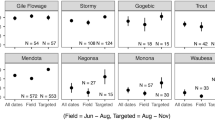Abstract
Euthecosomatous pteropods were collected in successive oblique plankton tows with 1 m diameter nets equipped with No. 0, No. 6, and No. 20 nylon mesh. Comparisons of samples revealed that the same species were collected by all 3 nets, but the No. 0 and No. 6 nets failed to collect veligers and juveniles of Spiratella inflata and Creseis virgula conica. Collections with nets of larger mesh size may erroneously suggest seasonal variations in population densities due, not to actual changes in total density, but to changes in the size of individuals and changes in the relative numbers of the different life stages. A large diameter net equipped with No. 20 mesh is recommended for work that includes the smallest life stages of tropical pteropods.
Similar content being viewed by others
Literature Cited
Boltovsky, D.: Pteropodos thecosomados del Atlantico suboccidental. Malacologia 11, 121–140 (1971).
Chen, C. and A. W. H. Bé: Seasonal distributions of euthecosomatous pteropods in the surface waters of five stations in the western North Atlantic. Bull. mar. Sci. Gulf Caribb. 14, 185–220 (1964).
Lalli, C. M. and F. E. Wells, Jr.: Brood protection in an epipelagic thecosomatous pteropod, Spiratella (“Limacina”) inflata (d'Orbigny). Bull. mar. Sci. (In Press).
Lewis, J. B. and A. G. Fish: Seasonal variation of the zooplankton fauna of surface waters entering the Caribbean Sea at Barbados. Caribb. J. Sci. 9 (1 and 2), 1–24 (1969).
McGowan, J. A. and V. J. Fraundorf: The relationship between size of net used and estimates of zooplankton diversity. Limnol. Oceanogr. 11, 456–469 (1966).
Moore, H. B.: The zooplankton of the upper waters of the Bermuda area of the North Atlantic. Bull. Bingham oceanogr. Coll. 12, 1–97 (1949).
Myers, T. D.: Horizontal and vertical distribution of thecosomatous pteropods off Cape Hatteras, 224 pp. Unpublished PhD. dissertation, Duke University 1968.
Tesch, J. J.: The thecosomatous pteropods. I. The Atlantic. Dana Rep. 28, 1–82 (1946).
Thiriot-Quievreux, C.: Variations saisonnières des mollusques dans le plancton de la région de Banyuls-sur-Mer (zone Sud du golfe de Lion) novembre 1965–décembre 1967. Vie Milieu (Sér. B) 20, 35–83 (1968).
Tranter, D. J. and J. H. Fraser (Eds.): Zooplankton sampling. Monographs on oceanographic methodology 2, 174 pp. Paris: U.N.E.S.C.O. 1968.
Wormelle, R. L.: A survey of the standing crop of plankton of the Florida Current. VI. A study of the distribution of the pteropods of the Florida Current. Bull. mar. Sci. Gulf Caribb. 12, 95–136 (1962).
Author information
Authors and Affiliations
Additional information
Communicated by T. R. Parsons, Vancouver
Rights and permissions
About this article
Cite this article
Wells, F.E. Effects of mesh size on estimation of population densities of tropical euthecosomatous pteropods. Marine Biology 20, 347–350 (1973). https://doi.org/10.1007/BF00354276
Accepted:
Issue Date:
DOI: https://doi.org/10.1007/BF00354276




